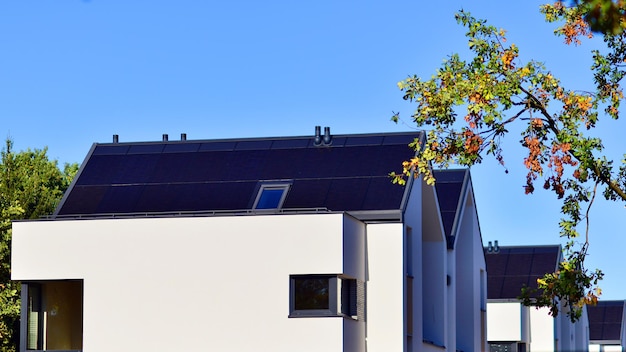New Federal Tax Credits for Energy Efficiency: Homeowners Guide for 2025

New federal tax credits for energy efficiency in 2025 offer homeowners opportunities to reduce energy consumption and lower tax burdens through incentives for energy-efficient upgrades and renewable energy installations, fostering environmental sustainability and cost savings.
Planning home improvements for 2025? You should be aware of the new federal tax credits for energy efficiency: What Homeowners Need to Know in 2025, as these could significantly reduce your project costs while boosting your home’s efficiency and value.
Understanding the Energy Efficiency Tax Credits Landscape in 2025
The energy efficiency tax credits landscape is evolving, and it’s crucial to understand the key components of the new federal tax credits for energy efficiency: What Homeowners Need to Know in 2025. These changes provide substantial opportunities for homeowners to make energy-efficient upgrades and claim significant tax savings in the process.
Brief History of Energy Efficiency Tax Credits
Tax credits for energy-efficient home improvements have been introduced in the past. These initiatives have been updated and expanded with the goal of increasing the adoption of clean energy technologies by homeowners across the United States.
Overview of Current Tax Credits
The current tax credits available to homeowners cover various types of energy-efficient upgrades, including solar panels, insulation, energy-efficient windows, and updated HVAC systems. These credits are designed to incentivize homeowners to invest in sustainable energy solutions and reduce their carbon footprint.

Here are some of the key aspects of the latest updates in energy efficiency tax credits you need to keep in mind:
- Increased Credit Amounts: Many previous credits have been increased, allowing homeowners to claim larger deductions.
- Expanded Eligibility: The eligibility criteria now include a broader range of energy-efficient products and improvements.
- Extended Availability: The updated tax credits are available for a longer duration, providing homeowners with more time to plan and implement energy efficiency projects.
Understanding the changes in the energy efficiency tax credits landscape is essential for homeowners looking to make cost-effective and environmentally friendly upgrades to their homes. Keeping up with these updates enables homeowners to take full advantage of the available incentives and maximize their savings while contributing to a more sustainable future.
Key Tax Credits Available for Homeowners in 2025
Several key tax credits are available for homeowners in 2025, providing financial incentives for specific energy-efficient upgrades. Knowing which credits you qualify for can significantly reduce your project costs and speed up your return on investment.
Residential Clean Energy Credit
This credit applies to renewable energy systems, such as solar, wind, and geothermal. It allows homeowners to claim a percentage of the cost of new, qualified clean energy property.
Energy Efficient Home Improvement Credit
This credit is for making qualified energy-efficient improvements to your home. This includes things like adding insulation, energy-efficient windows, doors, and certain types of HVAC systems.
Key features and eligibility requirements for these tax credits:
- Residential Clean Energy Credit: This credit typically covers up to 30% of the cost of new, qualified clean energy property, such as solar panels, wind turbines, and geothermal heat pumps.
- Energy Efficient Home Improvement Credit: This credit offers a percentage of qualified expenses, subject to certain limits. For example, there might be a cap on the amount you can claim for specific improvements like insulation or new windows.
- Requirements: To be eligible for the Residential Clean Energy Credit, homeowners must purchase and install new, qualified clean energy property. For the Energy Efficient Home Improvement Credit, the improvements must meet specific energy efficiency standards established by the Department of Energy.
Knowing the details of these credits will help you decide which projects to prioritize and how to plan your budget effectively. Consult with a tax professional to ensure you are claiming the credits properly and to understand how they apply to your specific situation. Proper planning can maximize your savings and make your home more energy-efficient.
Eligibility Requirements for Energy Efficiency Tax Credits
To take advantage of the new federal tax credits for energy efficiency: What Homeowners Need to Know in 2025, it’s crucial to understand the eligibility requirements. These requirements ensure that the credits are applied correctly and that homeowners receive the intended benefits. Meeting these criteria involves both the homeowner and the specific energy-efficient products being installed.
Homeowner Eligibility
To qualify for energy efficiency tax credits, homeowners must meet certain criteria related to their home and tax status. The credits are primarily for individuals who own the home where the improvements are made.
Property Requirements
The type and location of the property also play a role in eligibility. The relevant considerations include confirming the property is the homeowner’s primary residence to taking into account energy efficiency standards.

Here are key things you should know:
- Home Ownership: The individual claiming the credit must be the owner of the home.
- Primary Residence: The home must be the homeowner’s primary residence, meaning they live there most of the year.
- Energy Efficiency Standards: Equipment and products must meet or exceed the energy efficiency standards set by organizations like the Department of Energy (DOE) and ENERGY STAR®.
Understanding these eligibility requirements is essential to ensure that you qualify for the tax credits. Always keep detailed records of your purchases and installations, and consult with a tax professional or financial advisor to confirm your eligibility and navigate the tax filing process correctly. Staying informed and prepared will help you maximize your savings and confidently move forward with your energy-efficient home improvements.
Step-by-Step Guide to Claiming Your Tax Credits
Claiming the new federal tax credits for energy efficiency: What Homeowners Need to Know in 2025 involves a systematic process that ensures you receive the entitled benefits. By following a step-by-step approach, you can navigate the paperwork and requirements with confidence.
Gathering Necessary Documentation
Before you start the process, collect all necessary documents, including receipts, installation records, and product specifications.
Completing the Required Tax Forms
Next, you’ll need to fill out the necessary tax forms to claim your credits. This typically involves IRS forms related to energy efficiency and renewable energy credits.
Consider these steps:
- Collect Receipts: Gather all receipts from your purchases and installations. These should detail the costs of the products and labor.
- Obtain Installation Records: Keep records of the installation dates and any certifications provided by the installer.
- Download Forms: Visit the IRS website to download the relevant forms for claiming energy efficiency tax credits.
Proper documentation and accurate form completion is key to a smooth tax filing process. Keep all records organized and accessible, and don’t hesitate to seek professional assistance if needed. By carefully following this step-by-step guide, you can maximize your tax credits and enjoy the financial benefits of your energy-efficient home improvements.
Maximizing Your Savings with Energy Efficiency Tax Credits
To maximize your savings with energy efficiency tax credits, strategic planning and understanding available incentives is essential. Proper planning can help you identify projects that offer the greatest returns while ensuring you meet all eligibility criteria for tax credits. It’s also crucial to consider the timing of your upgrades and the potential to combine credits for even greater savings.
Strategic Project Planning
Consider an ideal approach to project planning to align with tax credit opportunities. What are the projects that will yield the highest return?.
Timing Your Upgrades
Understand when best to schedule your impovements and consider how timing can affect tax credit availability.
Here are some best practices:
- Plan Ahead: Evaluate your home’s energy needs and identify the areas where improvements will have the biggest impact. Prioritize projects that not only increase energy efficiency but also qualify for the most generous tax credits.
- Combine Credits: Investigate opportunities to combine different tax credits for even greater savings. For example, you might be able to combine credits for energy-efficient appliances with credits for renewable energy systems.
- Seek Professional Advice: Consult with energy efficiency experts, tax professionals, and financial advisors to develop a customized plan that maximizes your savings.
By implementing these strategies, you can maximize your savings potential with energy efficiency tax credits. Strategic project planning, careful timing, and professional guidance helps homeowners get the most out of these incentives. Investing in energy efficiency not only helps the environment but also provides significant financial benefits, making it a smart move for homeowners in 2025.
Future Outlook for Energy Efficiency Incentives
The future looks promising for energy efficiency incentives, with anticipated changes set to shape the landscape for homeowners. Keeping an eye on these upcoming developments is crucial for effectively planning future home upgrades. Policy updates enhance the value of existing credits, and new incentives could emerge to further promote energy efficiency. These advancements can make sustainable home improvements more affordable and accessible.
Potential Legislative Updates
Anticipate future changes in legislation that may impact the energy efficiency sector. The direction of government incentives and credit opportunities may also change.
Emerging Technologies and Incentives
Focus on incentives related to newer technologies and their potential impacts and how emerging technologies could shape future incentives. This includes innovations focused on energy and sustainability.
Some key points about the future outlook:
- Policy Changes: Stay informed about potential policy changes at the federal and state levels. These changes may introduce new incentives, increase existing credit amounts, or expand eligibility criteria.
- Technological Advancements: Keep an eye on emerging technologies in the energy efficiency sector. New innovations often lead to new incentives aimed at promoting their adoption.
- Long-Term Planning: Develop a long-term plan for energy-efficient home improvements. By staying ahead of the curve, you can strategically time your upgrades to take advantage of the most beneficial incentives.
By staying informed and planning strategically, homeowners can confidently navigate the changing energy efficiency landscape and maximize their savings potential. The future of energy efficiency incentives looks bright, so homeowners can look forward to more affordable, sustainable and accessible home improvement options. Staying proactive ensures that you make the most of these opportunities as they unfold.
| Key Point | Brief Description |
|---|---|
| 💡 Clean Energy Credit | Covers systems like solar, wind, and geothermal. Claim a percentage of costs. |
| 🏠 Home Improvement Credit | For energy-efficient upgrades like insulation, windows, doors, and HVAC. |
| ✅ Ensure Eligibility | Home must be primary residence; equipment must meet standards. |
| 💰 Maximize Savings | Plan projects strategically and consider combining credits. |
Frequently Asked Questions
What are the main energy efficiency tax credits available in 2025?
▼
The primary tax credits include the Residential Clean Energy Credit for renewable energy systems and the Energy Efficient Home Improvement Credit for upgrades like insulation, windows and HVAC.
What qualifies as a renewable energy system for the Residential Clean Energy Credit?
▼
Renewable energy systems include solar panels, wind turbines, and geothermal heat pumps installed to generate electricity or heat for your home, meeting certain code requirements.
What kind of home improvements qualify for the Energy Efficient Home Improvement Credit?
▼
Qualified home improvements include the installation of insulation, energy-efficient windows and doors, and upgrades to HVAC systems that meet or exceed energy efficiency standards.
Who is eligible to claim these energy efficiency tax credits?
▼
To claim these tax credits, you must own the home, and it must be your primary residence. Also, the energy efficient equipment must be new and installed during the tax year.
How do I claim the energy efficiency tax credits when filing my taxes?
▼
To claim the credits, you’ll need to complete and submit the relevant IRS forms, such as Form 5695, along with your tax return. Make sure to keep detailed records of all purchases and installations.
Conclusion
Understanding and utilizing new federal tax credits for energy efficiency: What Homeowners Need to Know in 2025 is a smart move for homeowners looking to save money and reduce their environmental impact. By staying informed, planning strategically, and consulting with professionals, you can maximize the financial benefits of energy-efficient home improvements. Embrace these incentives to create a more sustainable and comfortable home.
Read more content






